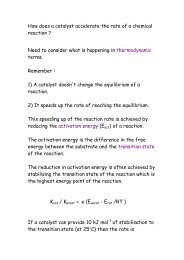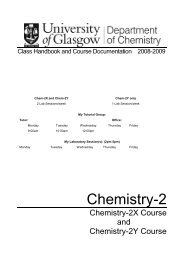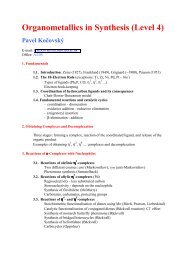Dr Louis Farrugia Room A4-36 Course Secretary: Fiona Ironside ...
Dr Louis Farrugia Room A4-36 Course Secretary: Fiona Ironside ...
Dr Louis Farrugia Room A4-36 Course Secretary: Fiona Ironside ...
You also want an ePaper? Increase the reach of your titles
YUMPU automatically turns print PDFs into web optimized ePapers that Google loves.
<strong>Course</strong> Head: <strong>Dr</strong> <strong>Louis</strong> <strong>Farrugia</strong> <strong>Room</strong> <strong>A4</strong>-<strong>36</strong><br />
<strong>Course</strong> <strong>Secretary</strong>: <strong>Fiona</strong> <strong>Ironside</strong> <strong>Room</strong> <strong>A4</strong>-04
Level 4M Chemistry With Medicinal Chemistry Session 2008 - 2009<br />
The course head is <strong>Dr</strong> <strong>Louis</strong> <strong>Farrugia</strong>, <strong>Room</strong> <strong>A4</strong>-<strong>36</strong><br />
E-mail: louis@chem.gla.ac.uk or Tel: 0141 330 5137 (direct).<br />
You are welcome to contact <strong>Dr</strong> <strong>Farrugia</strong> at any time about any aspect of the course, either directly<br />
or through the <strong>Course</strong> <strong>Secretary</strong>, <strong>Fiona</strong> <strong>Ironside</strong>, <strong>Room</strong> <strong>A4</strong>-04,<br />
Email: fionai@chem.gla.ac.uk or Tel: 0141 330 8618.<br />
LECTURE COURSES<br />
Compulsory Lecture <strong>Course</strong>s (Core 1 and Core 2): the eighteen compulsory courses are listed<br />
in the timetable. They are given during weeks 1 - 11.<br />
Option <strong>Course</strong>s: There are eight MSci option courses. Designated “O” in the timetable. You<br />
must attend at least three of these. You make your course selection on the notice board in week<br />
10. Only those courses with sufficient interest (normally a minimum of 4 students) will actually run<br />
and you may be required to alter your choice as a result of this.<br />
Code <strong>Course</strong> Lecturer<br />
H1 Advanced Organic Synthesis <strong>Dr</strong> R. Marquez<br />
H2 Pericyclic Reactions <strong>Dr</strong> A. Sutherland<br />
H3 Heterocyclic Systems Prof J. S. Clark<br />
H4 Colloids & Macromolecules <strong>Dr</strong> A. Freer<br />
H7 Metals in Medicine Prof L. Cronin<br />
M1 Industrial Medicinal Chemistry Organon<br />
M2 Cancer & Modern <strong>Dr</strong>ug Discovery <strong>Dr</strong> Hartley<br />
M3 & 4 Pharmacology 1 & 2 Prof Martin, <strong>Dr</strong> Skett & Prof Stone<br />
C1 Processing Chemical Data Prof C. J. Gilmore<br />
C2 Heterogeneous Catalysis <strong>Dr</strong> D. Lennon<br />
C3 Physical Organic Chemistry <strong>Dr</strong> G. Bucher<br />
C4 Inorganic Materials Design Prof D. Gregory<br />
C5 Reactivity of Transition Metal Organometallic <strong>Dr</strong> L. J. <strong>Farrugia</strong><br />
Compounds<br />
C6 Asymmetric Synthesis <strong>Dr</strong> L. Soler<br />
C7 NMR Spectroscopy Prof S. Wimperis<br />
C8 Organic & Bioorganic Supramolecular Chemistry <strong>Dr</strong> G. Cooke<br />
C9 The Periodic Table from an Electronic Perspective Prof J. McGrady<br />
Minimum of 3 of the following options:<br />
O1 Advanced Bio-Inorganic Chemistry Prof L. Cronin<br />
O2 Organometallics in Synthesis Prof P. Kocovsky<br />
O3 Modern Techniques in Surface Science <strong>Dr</strong> M. Kadodwala<br />
O4 Protein Structures-Design & Engineering Prof N. Isaacs<br />
O5 Advanced Retrosynthesis <strong>Dr</strong> R. Hartley<br />
O6 Molecular Magnetism <strong>Dr</strong> M. Murrie<br />
O7 Molecular Modelling <strong>Dr</strong> H. Senn<br />
O8 Total Synthesis of Natural Products Prof J. S. Clark<br />
O9 Applications of Synchrotron and Neutron Radiation Prof C. C. Wilson<br />
Refer to Level 4 <strong>Course</strong>s Handbook for Aims and Objectives<br />
- 2 -
Level 4M Chemistry With Medicinal Chemistry Session 2008 - 2009<br />
Attendance at Alchemist Club and local R.S.C. meetings, which are held on Thursdays at 4 pm, is<br />
recommended and encouraged.<br />
Lectures in Pharmacology: Before starting the pharmacology lecture courses M3 and M4, all<br />
students must read section 1 of Rang, H.P., Dale, M.M. & Ritter, J.M. (1999) “Pharmacology” 4th<br />
Edition. They must also read chapter 1 of Gibson, G.G. & Skett, P. (2001) 3rd Edition<br />
“Introduction to <strong>Dr</strong>ug Metabolism”. Before starting the CNS option course, students must read<br />
section 4 of Rang, H.P., Dale, M.M. & Ritter, J.M. (1999) “Pharmacology” 4th Edition.<br />
The pharmacology lectures are given in a style which chemistry students may find unfamiliar. The<br />
material is presented more descriptively. It will not usually be possible to copy down every spoken<br />
word. Students are advised to try to understand the lecture content at the time of presentation and<br />
to make a summary of the concept/theory in note form rather than in full sentences. They can<br />
also include relevant examples or annotated diagrams. Notes should be amplified later by<br />
referring to lecture handouts or textbooks. Past examination questions (reprints available from the<br />
Alchemist Club) indicate the breadth/depth of understanding required. Some Biology 2 material<br />
will be covered for the benefit of CMC 4H students who did not previously study Biology 2.<br />
Students who feel they have already seen this material should not absent themselves from<br />
lectures but should regard them as an opportunity for revision.<br />
Lectures by Visiting Speakers: The 4-M class are required to attend a number of the talks by<br />
external speakers in weeks 1- 24. These will normally be held on Thursdays or Fridays at 4pm.<br />
Details of which talks you should attend will be communicated to you nearer the time and a<br />
reminder will be sent by e-mail.<br />
TUTORIALS<br />
Organic: Alternate weeks 3-24 Mondays at 4 pm in tutor’s office.<br />
Physical: Alternate weeks 4-23 Mondays at 4 pm in the Carnegie or Physical Lecture Theatre.<br />
Inorganic: Inorganic staff will indicate when they are available.<br />
Pharmacology: Weeks 8-11 as marked on timetable.<br />
- 3 -
Level 4M Chemistry With Medicinal Chemistry Session 2008 - 2009<br />
STUDENT PROGRESS<br />
Your performance of class work will be considered satisfactory only if you:<br />
(a)<br />
(b)<br />
(c)<br />
(d)<br />
(e)<br />
(f)<br />
(g)<br />
(h)<br />
Regularly attend lectures and tutorials.<br />
Carry out a research project in weeks 2-24 following the timetable given later in this<br />
handbook.<br />
Give a short oral presentation on your MSci placement project (15 mins + 5 mins for<br />
questions) in weeks 3-5.<br />
Attend selected talks by external speakers.<br />
Submit an essay introduction to your project (as outlined in your third year documentation)<br />
by Friday of week 5 to <strong>Fiona</strong> <strong>Ironside</strong> (<strong>A4</strong>-04).<br />
Attend MSci placement talks on Friday afternoons of weeks 3-5, and attend MSci research<br />
talks in week 27.<br />
Give a Powerpoint presentation on your research project (15 mins + 5 mins questions) in<br />
week 27.<br />
Provide the Chemistry Department with two bound copies of a thesis on your project to be<br />
submitted to <strong>Fiona</strong> <strong>Ironside</strong> (<strong>A4</strong>-04) by 4pm on the 16th March. A further copy should be<br />
prepared and retained by you for your oral.<br />
During weeks 2-24 you are expected to devote at least 20 hours per week to your project.<br />
Persistent absentees from tutorials, lectures or laboratories will be asked to explain their behaviour<br />
to the Head of Department and credit for the course may be denied (i.e. you may not be allowed to<br />
sit the exams if you do not attend the course fully).<br />
EXAMINATIONS<br />
The degree examinations consist of a research project and six written examinations. There is also<br />
a third year carry-over mark and there are marks for essays and the oral presentation. Two of the<br />
written papers are each of three hours duration. All other written papers are of two and a quarter<br />
hours duration. The research project will be assessed on the basis of the thesis (30%), the work<br />
performed during the project (50%), and an oral examination on the contents of the thesis (20%).<br />
All students must be available for oral examination by the external examiners on Tuesday<br />
9 th June 2009 at 8:45 am. This is an integral part of the degree examination.<br />
A summary of all marks for your degree:<br />
Marks<br />
Carry-over from 3rd year 50<br />
Placement 100<br />
Placement talk to department 40<br />
Project Essay 30<br />
Level-4 examination papers (4x2.25h, 2x3h) 500<br />
Distance Learning 30<br />
Research project 100<br />
Research project oral presentation 40<br />
Total 890<br />
- 4 -
Level 4M Chemistry With Medicinal Chemistry Session 2008 - 2009<br />
EXAM STRUCTURE<br />
The final exam papers have a greater emphasis on 4th year material.<br />
MSci in Chemistry with Medicinal Chemistry<br />
Paper 1 MSci Physical Core 1 and Core 2<br />
3 questions from 4<br />
2 h 15 min<br />
75 marks<br />
Paper 2 MSci Inorganic Core 1 and Core 2<br />
3 questions from 4<br />
2 h 15 min<br />
75 marks<br />
Paper 3 MSci Organic Core 1 and Core 2<br />
4 questions from 6, [2 sections, at least 2 from section B (core 2)]<br />
3 h<br />
100 marks<br />
Paper 4 Medicinal Chemistry and Pharmacology<br />
3 questions from 4<br />
2 h 15 min<br />
75 marks<br />
Paper 5 MSci Options<br />
3 questions from approximately 8<br />
3 h<br />
100 marks<br />
Paper 6 MSci Problems based on Core 1 and Core 2 but including data from fundamental<br />
techniques and basic chemistry/medicinal chemistry assumed from earlier years in Core 1 and<br />
Core 2 courses.<br />
3 questions from 6, [Section A 2 organic, 1 medicinal and pharmacology. Section B: 3 drawn from<br />
physical and inorganic. At least 1 from each section]<br />
2 h 15 min<br />
75 marks<br />
Total marks = 500<br />
Important: The total number of questions on a paper is approximate and may change.<br />
- 5 -
Level 4M Chemistry With Medicinal Chemistry Session 2008 - 2009<br />
CONFERENCE ROOM<br />
You are welcome to use the Conference <strong>Room</strong> as a place to study provided that (a) it is not<br />
required for other departmental purposes, (b) you leave when requested by the janitors and (c)<br />
the room is kept quiet and tidy.<br />
ILLNESS AND ABSENCE FROM CLASSES<br />
If you are unable to attend classes you must follow the new University guidelines regarding<br />
absence, which are available at the following link:<br />
http://senate.gla.ac.uk/academic/policies/student_absence_policy.html<br />
You should also contact <strong>Dr</strong> <strong>Farrugia</strong> as soon as possible to explain the reasons for your absence.<br />
If you believe that your performance in the course has been adversely affected for reasons, which<br />
you wish to draw to the attention of the Board of Examiners, it is essential that you write to <strong>Dr</strong><br />
<strong>Farrugia</strong> to inform him of the circumstances.<br />
CHEMISTRY DEPARTMENT LIBRARY<br />
The Librarian, Mrs Denise Curry, has a selection of recommended textbooks which are available<br />
for short term loan. During term 1 she will run courses on how to make best use of the library.<br />
CAREERS TALK AND DISCUSSION<br />
Thursday 16th October 3 pm. "Careers for Chemists" Speakers from industry, the Department<br />
and the Careers Service will present their views of possible careers. This will be followed by an<br />
open-ended discussion.<br />
Individual interviews for all students will be arranged early in Term 1 to discuss their choices of a<br />
future career.<br />
- 6 -
Level 4M Chemistry With Medicinal Chemistry Session 2008 - 2009<br />
FOURTH YEAR PROJECT TIMETABLE<br />
Week 1 Students contact supervisors at 12 noon on Tuesday 23rd September.<br />
Supervisors give students two copies of a synopsis of the project including a title and<br />
leading references.<br />
One copy of the project synopsis should be given to <strong>Fiona</strong> <strong>Ironside</strong> (<strong>Room</strong> <strong>A4</strong>-04).<br />
Week 2 Practical work begins from the start of week 2. A COSHH form must be completed,<br />
signed by the supervisor and handed into the Departmental Office (<strong>Room</strong> <strong>A4</strong>-04).<br />
If the nature of the research changes during the project new COSHH forms must be<br />
completed.<br />
Week 4 Project assessors announced.<br />
Students contact assessors.<br />
Week 24 Friday: Last day of practical work.<br />
Week 25 Friday: Final draft of thesis approved by supervisor.<br />
Week 26 Monday: Deadline for submission of theses. Two bound copies to be submitted to<br />
<strong>Fiona</strong> <strong>Ironside</strong> (<strong>Room</strong> <strong>A4</strong>-04) on 16th March no later than 4pm. Students should<br />
retain an extra copy for themselves.<br />
Week 27 Thesis talks (15 mins + 5 mins questions - assessed).<br />
Weeks 26-27 Oral examinations: these will be conducted by the assessor and a second member<br />
of staff. The supervisor will not be present. You must arrange the time of this oral<br />
examination with your assessors.<br />
Please note that there is a very short time between the end of practical work and submission of<br />
the thesis. Be sure to begin writing your thesis before you finish work in the laboratory.<br />
- 7 -
Level 4M Chemistry With Medicinal Chemistry Session 2008 - 2009<br />
SAFETY<br />
The Departmental Safety Committee has issued the following guidelines.<br />
1. Experimental work should normally not start before 9.00 am and should finish by 5.00 pm.<br />
2. Prior approval by the supervisor must be obtained should it be necessary for a student to<br />
work even for short periods outwith these hours. The usual rules for late working will apply.<br />
If the supervisor has to leave before experimental work is complete, written permission must<br />
be given and in such cases a designated proxy (academic, post-doctoral or senior technical<br />
staff) must be present in the building.<br />
3. Access to IT equipment will be available only when Janitors are present in the building.<br />
POLICY ON SUMMATIVE ASSESSMENT<br />
All feedback on coursework used in assessment, including mid-year class exam/class test marks<br />
and laboratory grades, is strictly provisional for your guidance only, and is subject to ratification by<br />
the Board of Examiners and external examiners at the end of the academic year. You must retain<br />
all copies of assessed work (lab notebooks, exam scripts, etc.) and have them available for<br />
inspection by the examiners if requested at the end of the year. You will be given reasonable<br />
advance warning should this be required.<br />
PLAGIARISM<br />
Plagiarism is the submission of someone else’s work as one’s own without acknowledgment. As<br />
recent cases have shown, it is regarded as a serious offence against University discipline. You<br />
must read the Senate-approved Plagiarism Statement on pages 9 – 11 which explains university<br />
policy on plagiarism.<br />
Degrees from Glasgow University recognise personal achievement. It follows that any work you<br />
submit must be your own. It may be proper, and even desirable, to include words, data or ideas<br />
taken from books or articles, the world-wide web or even from other students in work you submit<br />
for assessment. But you must make it completely clear what is yours and what you have taken<br />
from others. If you copy someone else’s words you must enclose them with quotation marks. You<br />
should also give a verifiable reference: for example F.A. Cotton and G. Wilkinson, Advanced<br />
Inorganic Chemistry, Fifth Edition, John Wiley & Sons, New York, 1988, page 1219 or J. Smith,<br />
Level-3 Inorganic Laboratory Report, April 2 nd , 2000.<br />
This regulation applies to all work submitted for assessment, including lab reports, class tests and<br />
research projects unless you have specifically been told otherwise, for example in the case of a<br />
group project or when a number of students share experimental data.<br />
You will be required to sign a form stating that any work you hand in is your own.<br />
See University Guidelines at the following address:<br />
http://senate.gla.ac.uk/discipline/plagiarism/index.html<br />
- 8 -
Level 4M Chemistry With Medicinal Chemistry Session 2008 - 2009<br />
GUIDELINES FOR PRESENTING AND WRITING A THESIS<br />
The thesis counts for 40% of the marks assigned to the project and, in addition, is the only<br />
tangible result of the sixteen weeks of work which can be shown to the External Examiners. It is<br />
therefore important that you do not let yourself down by a badly written or produced thesis.<br />
TECHNICAL POINTS<br />
The thesis should be word processed (the Department now has an adequate number of PC’s with<br />
WORD 97 installed).<br />
The font should be clear. Fonts normally used are Times New Roman or Arial (usually 10, 11 or<br />
12 point). This document is written in Arial 10 pt with main headings in 12 pt bold and subheadings<br />
in 10 pt bold.<br />
The thesis should use 1.5 line spacing and have a reasonable margin on the left hand side to<br />
allow for binding. Margins of 3.17 cm left and right and 2.54 cm top and bottom are acceptable.<br />
Pages should be numbered consecutively, as should diagrams and spectra. Since the word<br />
processor will do the numbering for you, it is easier if you do not include whole page diagrams or<br />
spectra in the page numbering, but this is a matter of choice.<br />
Chemical structures can be drawn using Chem<strong>Dr</strong>aw or ChemWindow and copied into WORD 97.<br />
On the other hand there is nothing wrong with Xeroxing in structures (and indeed diagrams)<br />
provided that the result looks neat and clear.<br />
REFERENCES<br />
Referencing work is very important and is frequently badly done. The format shown in the<br />
following examples is that employed by the Royal Society of Chemistry. It should be used unless<br />
your supervisor suggests an alternative.<br />
1. Journal articles: (Journal in italics, year, volume no in bold, page no)<br />
I. A. Fallis, L. J. <strong>Farrugia</strong>, N. M. Macdonald and R. D. Peacock, J. Chem. Soc. Dalton Trans.,<br />
1989, 931.<br />
C. Macleod, R.C. Hartley and D.W. Hamprecht, Org. Lett., 2002, 4, 75-78.<br />
other possibilities are:<br />
unpublished work, in press, personal communication.<br />
2. Books: (Authors, Title in italics, publisher, place, year, vol no, page if necessary)<br />
F.A. Cotton and G. Wilkinson, Advanced Inorganic Chemistry, Fifth Edition, John Wiley &<br />
Sons, New York, 1988, page 1219.<br />
3. Theses:<br />
N. M. Macdonald, Ph. D. Thesis, University of Glasgow, 1994.<br />
P.A. Lovatt, B. Sc. Thesis, University of Glasgow, 1993.<br />
- 9 -
Level 4M Chemistry With Medicinal Chemistry Session 2008 - 2009<br />
CONTENT<br />
The thesis should contain:<br />
• Title page<br />
• Acknowledgements<br />
• Contents page (with page numbers)<br />
• A one page Abstract<br />
• Introduction<br />
• Experimental Section,<br />
• Results and Discussion (or Results and Discussion as separate sections)<br />
• Conclusions<br />
• References<br />
The above order is customary but sometimes the Experimental Section appears between<br />
Conclusions and References - consult your supervisor.<br />
The INTRODUCTION should set the work in context, review previous work (fully referenced),<br />
describe any techniques or theories with which you were unfamiliar when you began the research,<br />
and describe what you intended to do.<br />
The EXPERIMENTAL SECTION should give full experimental details of all reactions or<br />
experiments carried out. It is particularly important to indicate which are literature preparations<br />
and which are novel. If a literature preparation is reported it is important to note if you modified it<br />
or if it behaved in an unexpected way. New compounds should be as fully characterised as<br />
possible. It is a good idea to include the actual spectra of new compounds (and other bulky<br />
supporting data) in one or more Appendices.<br />
The DISCUSSION is extremely important and is often where students do not do themselves<br />
justice. A project where absolutely nothing has worked can be made interesting by discussing<br />
WHY things went wrong. In any case, the discussion is often where you show how much of the<br />
project you understood!<br />
The CONCLUSIONS should summarise the work and suggest how it could be continued in the<br />
future.<br />
The ABSTRACT will be similar to the Conclusions but should be concise and incisive - it is the first<br />
thing an examiner will read, and should encourage him or her to read the rest of the thesis!<br />
Finally: SPELL CHECK YOUR THESIS.<br />
- 10 -
Level 4M Chemistry With Medicinal Chemistry Session 2008 - 2009<br />
CHEMISTRY-3H & 4H: RECOMMENDED TEXTBOOKS FOR 2008-2009<br />
(a)<br />
ESSENTIAL PURCHASES Level-4 Students will already have most of these books.<br />
• Molecular models, table molecular model kit such as Organic/Inorganic Orbit kit, Orbit<br />
Molecular Building System, Cochranes of Oxford Ltd, Leafield, Oxford OX8 5NT, £13.20.<br />
• EITHER Inorganic Chemistry, Shriver, P W Atkins and C H Langford, OUP, 4th Edition, 2006,<br />
£37.99 OR Inorganic Chemistry, Houscroft and A.G Sharpe, Prentice Hall, 2nd Edition, 2004.<br />
• Biocoordination Chemistry, D E Fenton, Oxford Science Publications, £10.99.<br />
• Spectroscopic Methods in Organic Chemistry, D H Williams and I Fleming, McGraw-Hill, 5th<br />
Edition Revised, £39.99.<br />
• Organic Chemistry, J Clayden, N Greeves, S Warren and P Wothers, OUP, £<strong>36</strong>.99.<br />
• Physical Chemistry, R A Alberty and R J Silbey, John Wiley, 4th Edition, £37.95.<br />
• Introduction to Molecular Symmetry, J S Ogden, Oxford Chemistry Primers, £10.99<br />
• Molecular Quantum Mechanics, P W Atkins and R S Friedman, 4th Edition, OUP, 2004,<br />
£35.99.<br />
(b)<br />
RECOMMENDED READING<br />
• Basic Solid State Chemistry, Second Edition, A R West, John Wiley, £29.95.<br />
• Structural Methods in Inorganic Chemistry, E A V Ebsworth, D W H Rankin and S Craddock,<br />
Blackwell, 2nd Edition. Currently out-of-print but second hand copies may be available.<br />
Particularly useful for laboratory and tutorial work and helpful in problem solving.<br />
• The Mechanisms of Reactions at Transition Metal Sites, R A Henderson, Oxford Science<br />
Publications, £10.99.<br />
• Crystal Structure Determination, W Clegg, Oxford Chemistry Primers, £10.99.<br />
• Foundations of Science Mathematics, D S Sivia and S G Rawlings, Oxford Chemistry Primers,<br />
£10.99, uses relevant chemical problems to illustrate the mathematical material. There is an<br />
accompanying text of Worked Problems (ISBN 019 850429) in the same series. Also worth a<br />
look is<br />
• Beginning Mathematics for Chemistry, S K Scott, OUP, £22.99.<br />
ESPECIALLY RELEVANT TO LEVEL-3 COURSES<br />
• Workbook for Organic Synthesis: The Disconnection Approach, S Warren, Wiley, £29.95.<br />
• Reactive Intermediates, C J Moody and G H Whitham, Oxford Chemistry Primers, £10.99.<br />
• Stereoselectivity in Organic Synthesis, G Procter, Oxford Chemistry Primers, £10.99.<br />
• Chemical Aspects of Biosynthesis, J Mann, Oxford Chemistry Primers, £10.99.<br />
• Stereoelectronic Effects, A J Kirby, Oxford Chemistry Primers, £10.99.<br />
ESPECIALLY RELEVANT TO LEVEL-4 COURSES<br />
• Aromatic Heterocyclic Chemistry, D T Davies, Oxford Chemistry Primers, 1997, £10.99.<br />
• Pericyclic Reactions, I Fleming, Oxford Chemistry Primers, £10.99.<br />
• Ions in Solution, J Burgess, Horwood Publishing, Chichester, 2nd Edition, 1999, ISBN 1-<br />
898563-50-0.<br />
• Chemical Bonding and Molecular Geometry, R J Gillespie and P L A Popelier, Oxford<br />
University Press, New York, 2001, ISBN 0-19-510496-X, £29.99.<br />
- 11 -
Level 4M Chemistry With Medicinal Chemistry Session 2008 - 2009<br />
CHEMISTRY ONLY<br />
• Beginning Group Theory for Chemistry, P H Walton, OUP, 1998, £29.99.<br />
• Molecular Symmetry & Group Theory, R L Carter, Wiley, 1998, £40.95.<br />
NOTE: All prices are subject to change by publishers at any time.<br />
(c)<br />
BOOKS AVAILABLE FOR CONSULTATION IN THE CHEMISTRY BRANCH LIBRARY<br />
INORGANIC CHEMISTRY<br />
• Advanced Inorganic Chemistry, F A Cotton and G Wilkinson, John Wiley, 6th Edition.<br />
• Chemistry of the Elements, N N Greenwood and A Earnshaw, Pergamon, 2nd Edition.<br />
More of a reference book than a text book, but contains factual information, particularly for main<br />
group elements, which is more complete than in Cotton and Wilkinson.<br />
• Some Thermodynamic Aspects of Inorganic Chemistry, D A Johnson, Cambridge U.P, 2nd<br />
Edition. (Out of Print)<br />
• Inorganic Chemistry, A G Sharpe, Longman, 3rd Edition.<br />
• Orbitals, Terms and States, M Gerloch, John Wiley, out of print.<br />
A small book that should help to clarify difficulties in understanding the nature of orbitals, terms<br />
and states. Relevant to many courses in Inorganic and Physical Chemistry.<br />
• The Elements, Their Origin, Abundance and Distribution, P A Cox, O.U.P.<br />
Useful background and revision materials for Radiochemistry courses.<br />
• A Guide to Modern Inorganic Chemistry, S M Owen and A T Brooker, Longman.<br />
Sets out to answer the questions that are asked most often by students. A revision aid.<br />
• Heterogeneous Catalysis. Principles and Applications, G C Bond, O.U.P.<br />
• Environmental Chemistry – A Global Perspective, G W van Loon and S J Duffy, O.U.P.,<br />
2005, 2nd Edition<br />
ORGANIC CHEMISTRY<br />
• A Guidebook to Mechanism in Organic Chemistry, P Sykes, Longmans, 6th Edition.<br />
• Some Modern Methods of Organic Synthesis, W Carruthers, Cambridge U.P, 4th Edition.<br />
• Guidebook to Organic Synthesis, R K Mackie, D M Smith and R A Aitken, Longman, 3rd<br />
Edition.<br />
• Advanced Organic Chemistry - Reactions, Mechanisms and Structure, 5th Edition, J March,<br />
John Wiley. The definitive reference work which is an excellent and complete source of<br />
references.<br />
• Secondary Metabolism, J Mann, Carendon Press, 2nd Edition.<br />
• Medicinal Chemistry, C R Ganellin and S M Roberts, Academic Press, 2nd Edition.<br />
- 12 -
Level 4M Chemistry With Medicinal Chemistry Session 2008 - 2009<br />
ESPECIALLY RELEVANT TO LEVEL-4 COURSES<br />
• Heterocyclic Chemistry, T L Gilchrist, Longman, 3rd Edition.<br />
• Heterocycles in Life and Society, A F Pozharskii, A T Soldatov and A R Katritzky, Wiley.<br />
• Non-Benzenoid Conjugated Carbocyclic Compounds, D Lloyd, Elsevier. (Out of print)<br />
• Molecular Biology of the Gene, Volumes 1 & 2, J D Watson et al., Benjamin//Cummings, 4th<br />
Edition.<br />
• Organic Chemistry - A Guide to Common Themes, T Kitson, Edward Arnold.<br />
A very readable overview of concepts and reaction types.<br />
PHYSICAL CHEMISTRY<br />
• Chemical Applications of Group Theory, F A Cotton, John Wiley, 3rd Edition.<br />
• Tables for Group Theory, P W Atkins, M S Child and C S G Phillips, O.U.P.<br />
• Chemical Bonding Theory, B C Webster, Blackwell Scientific, Oxford, 1990.<br />
• Modern Spectroscopy, 4th Edition, J M Hollas, John Wiley.<br />
• Fundamentals of Molecular Spectroscopy, C N Banwell, McGraw-Hill, 4th Edition.<br />
• Crystal Structure Analysis: A Primer, J P Glusker and K N Trueblood, O.U.P., 2nd Edition.<br />
• Symmetry and Structure, S F A Kettle, John Wiley.<br />
• Biophysical Chemistry, C R Cantor and P R Schimmel, W H Freeman & Co.<br />
• Physical Biochemistry, D Freifelder, W H Freeman & Co.<br />
• Protein Structure - A Practical Approach, T E Creighton, IRL Press, 2nd Edition.<br />
• Introduction to Protein Structure, C Branden and J Tooze, Garland Publishing, 2nd Edition.<br />
• Physical Biochemistry: Principles and Applications, D Sheehan, Wiley.<br />
• Physical Chemistry, P W Atkins, OUP, 8th Edition.<br />
• Molecular Modelling. Principles & Applications, A R Leach, Addison Wesley Longman, 2nd<br />
Edition, 2001<br />
• Computational Chemistry, G H Grant and W G Richards, Oxford Chemistry Primers.<br />
- 13 -


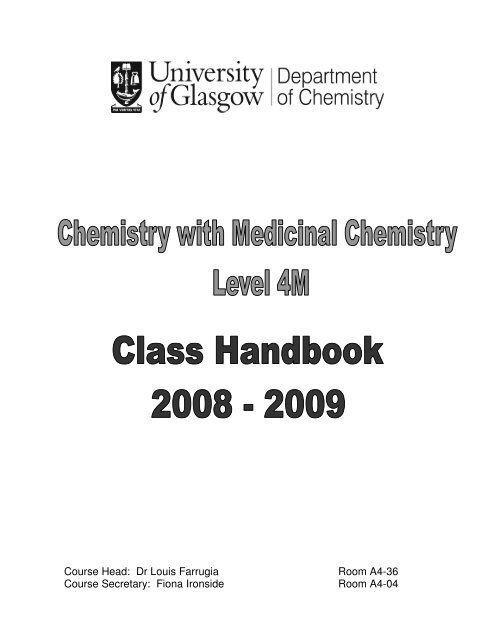
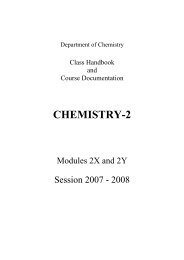

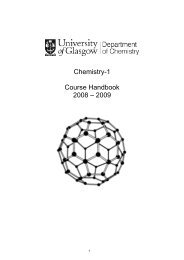
![Chemistry Study [PDF] - University of Glasgow](https://img.yumpu.com/26854063/1/184x260/chemistry-study-pdf-university-of-glasgow.jpg?quality=85)
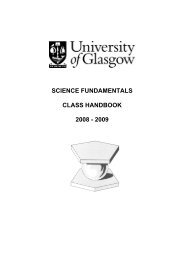

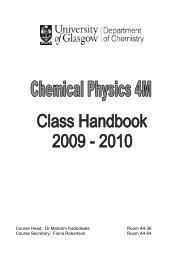
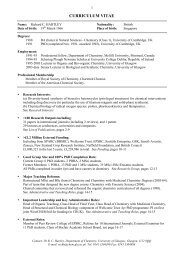
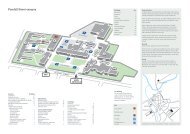
![Environmental Chemistry Study [PDF] - University of Glasgow](https://img.yumpu.com/26854018/1/184x260/environmental-chemistry-study-pdf-university-of-glasgow.jpg?quality=85)


